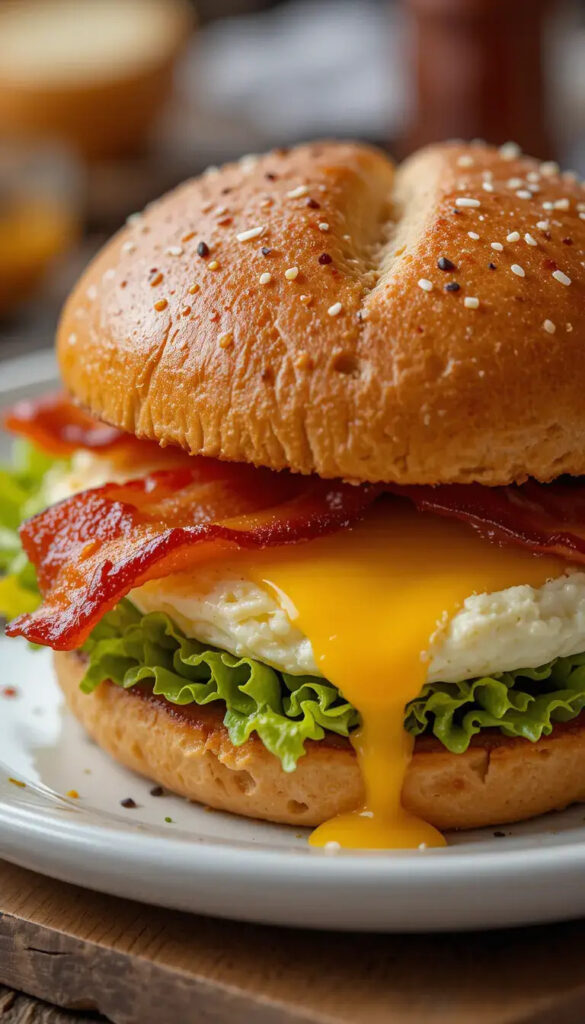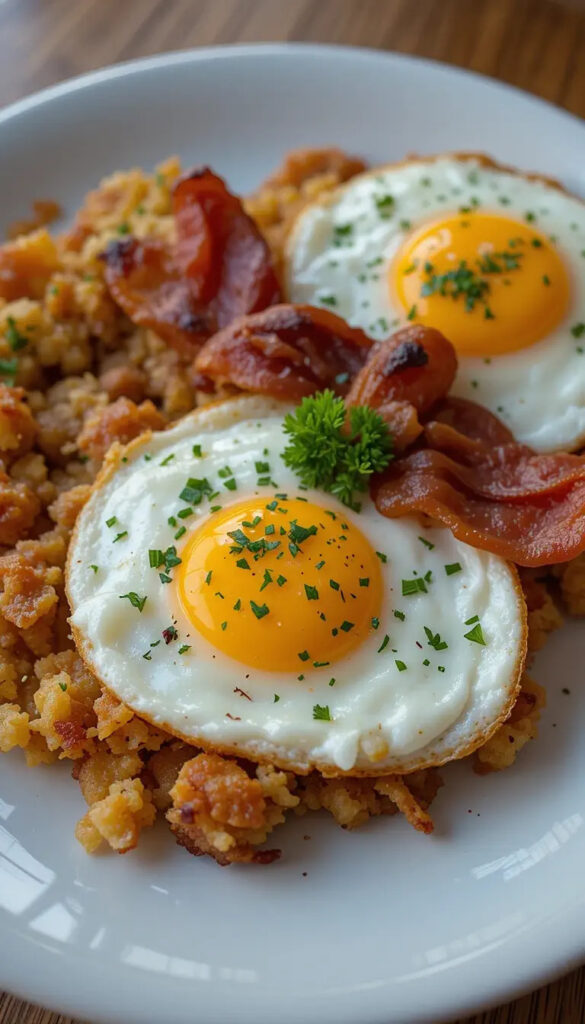Table of Contents
Let’s be honest: fried eggs are a breakfast superstar. They’re quick, delicious, and versatile. Whether you’re whipping up a hearty breakfast or throwing one on top of toast, fried eggs are an all-time favorite. But did you know there are four main types of fried eggs? Each has its own unique look, texture, and cooking style. Let’s crack this egg (pun intended!) and explore the fried egg universe.
Fried eggs have been a breakfast staple for ages, and it’s not hard to see why. They’re easy to make, pair well with almost anything, and offer a protein-packed start to your day. From fluffy pancakes to buttery toast, fried eggs are the perfect companion. But it’s not just about slapping an egg on a pan—how you cook it makes all the difference.
Why Are Fried Eggs Popular Worldwide?
Ever wonder why fried eggs are a global phenomenon? For starters, they’re incredibly simple yet versatile. You can keep them basic or dress them up with seasonings and toppings. Plus, they fit seamlessly into dishes from around the world, like huevos rancheros in Mexico or nasi goreng in Indonesia. Fried eggs transcend borders, bringing people together with their golden yolks and crispy edges.
What are the four types of fried eggs?
Not all fried eggs are created equal. The four main types are:
- Sunny Side Up
- Over Easy
- Over Medium
- Over Hard
Each type has a distinct appearance, texture, and flavor. Let’s break them down one by one!
1. Sunny Side Up
What Is a Sunny Side Up Egg?
Sunny side up eggs are the poster child of breakfast foods. The yolk remains runny, sitting on top like a shiny, golden sun (hence the name). The whites are fully cooked but tender, creating a beautiful contrast with the yolk.
How to Cook Sunny Side Up Eggs Perfectly
Here’s the secret: low and slow heat. Start by heating a non-stick pan over low heat and adding a bit of oil or butter. Crack the egg gently into the pan without breaking the yolk. Cook it until the whites are set but the yolk is still vibrant and runny. No flipping required!
Pro Tip: Cover the pan with a lid for a few seconds to cook the top of the egg without flipping it. It’s a game-changer!
Common Problems and Solutions for Sunny Side Up Eggs
- Problem: Whites don’t cook evenly.
Solution: Use a lid to trap steam and cook the whites faster. - Problem: The yolk breaks.
Solution: Crack the egg into a bowl first, then slide it gently into the pan.
Sunny side up eggs may seem simple, but getting them just right takes a bit of practice!
2. Over Easy
What Is an Over Easy Egg?
An over easy egg is flipped during cooking, but only briefly. The whites are fully cooked, and the yolk remains runny. Think of it as a flipped sunny side up.
Step-by-Step Guide to Cooking Over Easy Eggs
- Heat your pan over medium heat and add a little oil or butter.
- Crack the egg into the pan and let it cook until the whites are set.
- Gently flip the egg with a spatula and cook for about 10-15 seconds.
- Slide it onto a plate and enjoy!
Flipping can feel intimidating at first, but with a steady hand (and a good spatula), you’ll master it in no time.
Troubleshooting Over Easy Eggs
- Problem: Whites stick to the pan.
Solution: Make sure the pan is non-stick and properly greased. - Problem: The yolk breaks during flipping.
Solution: Flip gently and quickly with confidence.
Table: Ingredients and Cooking Times
| Type of Egg | Cooking Time | Key Ingredient |
|---|---|---|
| Sunny Side Up | 3-4 minutes | Butter or oil |
| Over Easy | 4-5 minutes | Butter or oil |
Key Differences Between Sunny Side Up and Over Easy
Sunny side up eggs are never flipped, leaving the yolk fully exposed, while over easy eggs get a quick flip to cook the whites on top. Both have runny yolks, but the texture and appearance differ slightly. Which one do you prefer? It’s like choosing between pancakes and waffles—tough, right?
3. Over Medium
Understanding Over Medium Eggs
If you’re looking for a middle ground between runny and fully cooked yolks, over medium eggs are your best bet. The yolk is partially set, offering a creamy, custard-like texture that’s perfect for those who want something in between.
How to Achieve the Perfect Over Medium Texture
Over medium eggs require precise timing. Here’s how to nail them:
- Heat your pan over medium heat and add a bit of oil or butter.
- Crack the egg into the pan and let the whites cook until set.
- Flip the egg gently and cook for an additional 30-45 seconds.
- Remove from the pan and enjoy the perfect balance of texture!
Pro Tip: Timing is key. Overcooking turns it into an over hard egg, so keep an eye on the clock!
Mistakes to Avoid When Cooking Over Medium Eggs
- Problem: Whites are undercooked.
Solution: Ensure the first side cooks fully before flipping. - Problem: Yolks cook through completely.
Solution: Reduce the cooking time on the flipped side.
4. Over Hard
What Sets Over Hard Eggs Apart?
Over hard eggs are for those who love their yolks fully cooked. The yolk is firm and doesn’t run at all, making them ideal for sandwiches or on-the-go meals. Think of them as the well-done steak of the fried egg world.
Tips for Cooking Over Hard Eggs Perfectly
Cooking over hard eggs is straightforward:
- Heat a pan over medium heat with oil or butter.
- Crack the egg into the pan and let the whites set.
- Flip the egg and cook until the yolk is firm, about 1-2 minutes.
- Remove and serve!
The key here is patience. Letting the yolk cook fully ensures the perfect over hard egg every time.
Fixing Problems: When Over Hard Eggs Go Wrong
- Problem: Whites become rubbery.
Solution: Use lower heat to cook the egg gently. - Problem: Egg sticks to the pan.
Solution: Ensure the pan is non-stick and well-lubricated.
Common Mistakes When Cooking Fried Eggs
Even seasoned cooks can make mistakes with fried eggs. Here are the most common pitfalls and how to avoid them:
- Using the Wrong Pan: A non-stick pan is your best friend for fried eggs. Anything else might leave you scraping bits of egg off the surface.
- Incorrect Heat Settings: Too high, and you’ll scorch the bottom; too low, and you’ll wait forever. Medium heat is the sweet spot.
- Overcooking or Undercooking: Timing is everything. A few seconds can make or break your fried egg.

Tips for Mastering the Art of Fried Eggs
Want to become a fried egg pro? Follow these tips:
- Choose the Right Pan and Tools: A non-stick pan and a silicone spatula are your best bets for hassle-free cooking.
- Control Heat Effectively: Start on medium heat and adjust as needed. Remember, patience is key.
- Experiment with Seasonings: A pinch of salt and pepper is classic, but why not try smoked paprika, garlic powder, or even a dash of hot sauce?
And don’t forget to play around with toppings. Fried eggs love to be dressed up!
Pairing Fried Eggs with Other Dishes
Fried eggs are incredibly versatile. Here are some classic and creative pairings:
- Classic Breakfast: Pair sunny side up eggs with bacon, toast, and hash browns for a hearty start to your day.
- Avocado Toast: Top your toast with mashed avocado, a sunny side up egg, and a sprinkle of chili flakes. Heaven!
- Burgers and Bowls: Add an over medium egg to your burger or grain bowl for an extra layer of flavor and texture.
The Health Benefits of Eating Fried Eggs
Let’s talk nutrition. Fried eggs are a great source of protein, vitamins, and healthy fats. They’re also incredibly satisfying, keeping you full for longer.
Table: Nutrition Facts for a Fried Egg (Per Egg)
| Component | Amount |
|---|---|
| Calories | 90 |
| Protein | 6 g |
| Fat | 7 g |
| Cholesterol | 185 mg |
| Vitamin B12 | 0.6 µg |
Of course, moderation is key, especially if you’re watching your cholesterol intake. But as part of a balanced diet, fried eggs are a fantastic choice!
Frequently Asked Questions
Can You Make Fried Eggs Without Oil?
Yes, you can! A non-stick pan is essential for frying eggs without oil or butter. Simply preheat the pan over medium heat, crack the egg in, and let it cook gently. However, keep in mind that oil or butter adds flavor and helps achieve crispy edges. If you’re avoiding fats, try using a cooking spray or even a small splash of water to steam the egg lightly.
How Long Does It Take to Cook Fried Eggs?
The cooking time depends on the type of fried egg:
- Sunny Side Up: 3-4 minutes
- Over Easy: 4-5 minutes
- Over Medium: 5-6 minutes
- Over Hard: 6-7 minutes
Always keep an eye on the eggs while cooking since slight variations in pan temperature can change the timing.
Why Do My Eggs Stick to the Pan?
Sticking is a common issue, usually caused by using a pan that isn’t non-stick or by insufficient lubrication. To prevent this, make sure your pan is non-stick, well-heated, and greased with oil, butter, or a cooking spray before adding the egg.
What’s the Best Way to Flip Fried Eggs?
Flipping fried eggs can be tricky, but here are some tips:
- Use a thin, flexible spatula to slide under the egg gently.
- Flip quickly and confidently to avoid breaking the yolk.
- Practice! The more you do it, the easier it gets.
Still nervous? Try flipping the egg in a non-stick pan with a quick wrist motion—it’s fun and surprisingly effective!
Can I Make Fried Eggs Ahead of Time?
Fried eggs are best eaten fresh, but you can make them ahead for meal prep. Slightly undercook the yolk if you plan to reheat them, as it will continue cooking during reheating. To reheat, place the egg in a warm pan for 1-2 minutes or microwave for 10-15 seconds.
What’s the Secret to Crispy Edges?
The key to crispy edges lies in higher heat and a little more oil. Heat your pan until the oil is shimmering, then add the egg. The edges will sizzle and crisp up beautifully while the yolk stays runny.
Can I Use Seasonings While Cooking Fried Eggs?
Absolutely! Sprinkle salt, pepper, or your favorite seasonings directly onto the egg while it cooks. For extra flair, try smoked paprika, garlic powder, or a dash of chili flakes. Want to get fancy? Drizzle a bit of truffle oil for a gourmet touch.
How Do I Avoid Breaking the Yolk?
To keep the yolk intact:
- Crack the egg into a small bowl first, then gently slide it into the pan.
- Use a low heat setting to prevent rapid cooking, which can disturb the yolk.
- Handle the egg gently when flipping or transferring it to a plate.
Is It Safe to Eat Runny Yolks?
For most people, runny yolks are perfectly safe as long as the eggs are fresh and properly handled. If you’re concerned about food safety, ensure the egg whites are fully cooked, and choose pasteurized eggs.
What Are Some Creative Toppings for Fried Eggs?
Fried eggs are a blank canvas for creativity! Here are some tasty topping ideas:
- Avocado slices and hot sauce
- Shredded cheese and fresh herbs
- Caramelized onions and sautéed spinach
- Crumbled bacon or sausage bits
- Salsa and a dollop of sour cream
The possibilities are endless—experiment and find your favorite combo!

Last Bite
What are the four types of fried eggs? Now you’re a fried egg aficionado! From sunny side up to over hard, you’ve got all the tips and tricks to cook each type to perfection. Whether you’re impressing friends at brunch or perfecting your own breakfast routine, fried eggs are your ticket to deliciousness. So grab a pan, crack some eggs, and get cooking!
“The difference between a good breakfast and a great one? It’s all in the egg!” 🥚🍳

